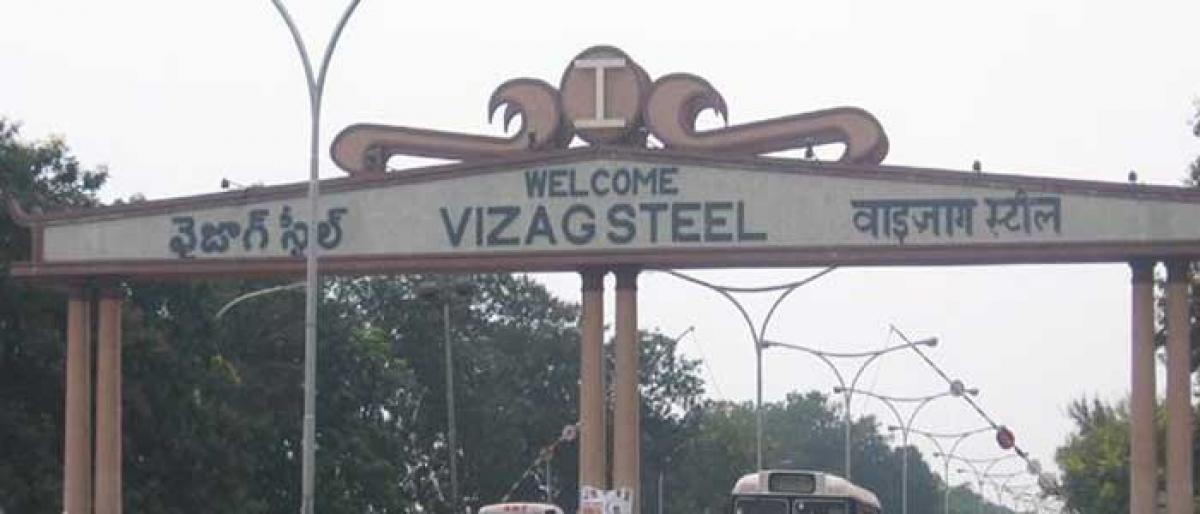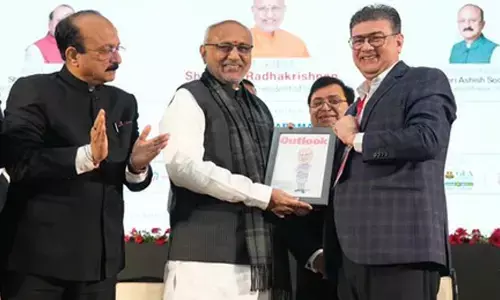Selling the family silver

The government seems to be all set for initiating the process of privatisation of the prestigious Visakhapatnam Steel Plant (VSP). The Central government has dropped indications to this effect when the Minister for State in charge of steel told Parliament recently that the Union government has decided to sell 10 per cent stake in the Visakhapatnam Steel Plant (VSP).
The government seems to be all set for initiating the process of privatisation of the prestigious Visakhapatnam Steel Plant (VSP). The Central government has dropped indications to this effect when the Minister for State in charge of steel told Parliament recently that the Union government has decided to sell 10 per cent stake in the Visakhapatnam Steel Plant (VSP).
The immediate reason cited for privatisation is the accumulated losses of the steel plant. The plant incurred losses to the tune of Rs 1,421 crore in 2015-16 and Rs 1,236 crore in 2016-17. But, the plant earned gross margins in the months of November and December 2017. This means the government aims at handing over the plant with healthy finances to the private companies.
The first phase of the plant was completed with 3.2 million tonnes capacity and the estimated cost was Rs 8,652 crore. The government invested Rs 4,889 crore only. The second phase of the plant was done with an estimated capacity of 6.3 million tonnes and the estimated cost was Rs 12,300 crore. The management plans to expand the capacity to 7.3 million tonnes with a cost of another Rs 4,000 crore. In fact, the government has not extended any fiscal assistance for the second phase of the plant. The second phase of the plant was executed with internal resources and market borrowings only.
Undervaluing the assets
The obnoxious part of the privatisation story is the way the company's net worth is calculated. The steel plant has acquired 22,000 acres by paying a compensation of Rs 12,500 per acre in 1970s. This cost is now taken into account for arriving at the net worth of the plant for selling the stakes. But, the present cost of the land is Rs 4 to 5 crores per acre. Such a faulty calculation would ensure a bonanza for the private players at the cost of people's assets built over a period of time.
The SEBI valued the plant net worth as Rs 4,889 crore. Thus, 10 per cent of the stakes in the plant will be given to private players at a paltry amount of Rs 489 crore. The actual net worth of the Visakhapatnam Steel plant is as high as Rs 2 lakh crore. The attempts to undervalue the assets of the public sector units (PSUs) is the political economy of disinvestment and privatisation in India.
The steel plant has so far paid Rs 36,000 crores as dividend and taxes besides spending as part of its Corporate Social Responsibility (CSR).
Boost to growth
The Gross District Domestic Product of Visakhapatnam is the highest in the state of Andhra Pradesh. Similarly, Gajuwaka leads in the per capita income among all the mandals of the state. All this could not have been possible without the Visakhapatnam steel plant remaining in public sector. The steel plant pays Rs 2,400 crore as salaries to its employees every year. This is generating huge demand in the local market, resulting in the overall demand-induced economic growth of the mandal and the district.
Infuse equity
The government is writing off the bad loans of several big corporates, especially those operating in the infrastructural sector. The loans taken by these big corporate companies are turning out into non-performing assets (NPAs) for the banks or the loans being rescheduled in the name of corporate debt restructuring (CDR). But, if the government extends the same largesse or at least converts the market borrowing taken by the plant into equity, the company would run into profits.
No captive mines
The Government of India has allocated captive iron ore mines for several private steel pants like Tatas, Mittals etc. But, the same government refuses to allocate a captive iron ore mines for Visakhapatnam Steel Plant owned by itself. Surprisingly, the steel plant and the iron ore mines are under the same Ministry of Steel and Mines.
As a result of not having own captive iron ore mine, the VSP has to spend at least Rs 2,000 to Rs 3,500 more per tonne of raw material depending on the rate of iron ore in the market at a given point of time. The steel plant with its present production capacity requires 7.5 million tonnes of iron ore.
Thus , even conservative estimates reveal that this public owned steel plant has to incur an additional expenditure of Rs 1,500 crore per year on procuring raw material from the market as it does not have any captive mines. If the steel plant gets own captive mines, it would automatically wipe out the entire losses. This also reveals that the losses of this plant are induced by the wrong government policies.
The Obulapuram iron ore mines were handed over to Gali Janardhana Reddy for a pittance. Thus, the iron ore was legally and illegally exported, while the domestic steel industry, especially the Visakhapatnam Steel Plant, was deprived of captive iron ore mines which would have substantially reduced the cost of its steel production.
Similarly, the steel plant is also asked to pay higher power tariff during peak hours. For instance, the power tariff for steel plants in India is 50 to 100 per cent higher as compared to even developed nations. Besides, the plant faces severe water scarcity during summer season.
Cheap imports
The deregulation of steel industry led to indiscriminate imports of steel into the Indian domestic market. The dumping of cheaper steel from other countries is proving to be a death-knell for Indian domestic steel industry including that of the Visakhapatnam Steel Plant.
The NITI Aayog member V K Saraswat has said that though India is the third largest steel maker in the world, a global glut and surge in cheap imports from China, Russia, Korea and Japan has dented the fortunes of domestic steel industry. This happens at a time when Visakhapatnam Steel Plant is expanding its production capacity.
Fiscal burden
Saraswat has further said that steel sector which has long gestation period needs long-term finance which has the capacity to withstand cyclical volatility of profits unlike funding from banks, external commercial borrowings or capital markets. But, VSP was asked to depend on market borrowings.
The Steel Plant has to bear a fiscal burden of Rs 600 crore on interest payments and Rs 900 crore depreciation cost. Thus, the losses of the Plant cited above are not real but manufactured by the wrong policies of the government. If the government had infused necessary equity into the plant for the expansion, the company wouldn't have incurred losses.
Uncompetitive input costs
The domestic steel industry is becoming uncompetitive due to higher freight costs, higher credit costs, industrial power tariffs, high iron ore costs, import duties and cess on coking coal, the NITI Aayog member explained. For example, freight costs from Jamshedpur to Mumbai can be as high as $50 per tonne in comparison with $34 a tonne from Rotterdam to Mumbai.
The Visakhapatnam Steel Plant is forced to face the burden of all these factors that make it uncompetitive on which the plant has no control. Then, why blame the Steel plant for the losses? Is it not to prepare a ground for blatant privatisation aimed at ushering huge financial benefit for private players? This is how the crony capitalism works in India.
Faulty marketing
The faulty marketing policies also contributed to the fiscal mess of the plant. The consumers have to purchase Visakhapatnam Steel mainly from the dealers. This results in huge profits for the dealers at the cost of both the steel plant, the producer and the consumers of steel.
Induce demand
The steel consumption in rural areas is marginal. It is estimated at 10 kg per capita. The rural steel consumption can be significantly enhanced by encouraging agro-based industries.
The per capita steel consumption of total finished steel stood at 63 kg in India, while for 2016, the world average was at 208 kg. (Source: World Steel Association, which reports data on a calendar year basis)
The level of consumption of steel depends on a number of factors, including stage of development, speed of economic growth etc.
The reconstruction of Andhra Pradesh post-bifurcation, especially the rising of Amaravati, provides an opportunity for encouraging the prestigious Visakhapatnam Steel Plant which was achieved as an epitome of Telugu pride. The Government of Andhra Pradesh should resolve to use Visakhapatnam steel only for the massive construction activity it is taking up in Amaravati and elsewhere in the state. Thus, the expansion of Visakhapatnam Steel Plant would turn into a blessing for the plant.
The indiscriminate expansion of the Steel Plant without expanding the market and addressing the factors that make it uncompetitive are the reasons for its fiscal woes. Instead of addressing these factors that cause fiscal strain on the steel plant, the central government seems to be hell-bent on outright privatisation to benefit private players which is nothing but selling the family silver.















